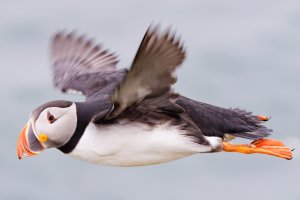You always have amazing shots.They are very nice shots and I and many others would be happy to have them. But, I am not sure they are good examples to use as examples that you can get critically sharp photos of birds at low shutter speeds. For a start, we can't download them and we don't know whether they are 100% crops. Here are a couple of shots of mine from earlier this year of puffins taken with the RF 100-500 at 1/4000s on the R7, one of which with sandeels is very similar to yours. These are 100% crops that can be downloaded for comparison. Are these sharper? My experience is that fast shutter speeds do improve sharpness.
View attachment 211746View attachment 211747
I agree with what you say. For me, I can get at least some acceptable shots slower than the seconds per focal length ratio, but a faster shutter speed will be much better almost every time. I tend to use a slower speed for something that isn't moving or moving slowly, but I've found after finishing with that subject, it best to adjust to a faster shutter speed. I've missed the chance to get a reasonable attempts at birds in flight or wild deer running in the forest because I failed to remember to do this.
Upvote
0


